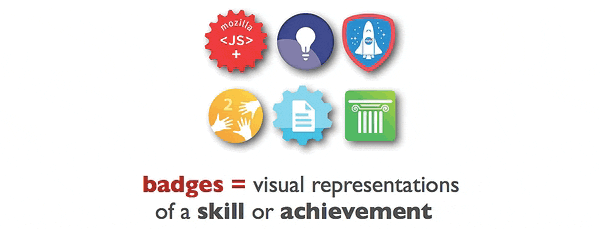SATs, ACTs, GPAs, résumés, curriculum vitae. For prospective college students and recent college graduates, these measures of academic aptitude can mean the difference between attending the college or getting the job of their dreams, and struggling to find one at all. But balancing high test scores, grades and extracurricular activities in order to present oneself as a well-rounded candidate is no easy task.
Now there’s something new to add to the resume or college application — digital badges. Think of them as a digital version of the merit badges that kids sew onto their sashes and vests in Girl Scouts and Boy Scouts. These online indicators can be added to a person’s portfolio or LinkedIn account to demonstrate skills, accomplishments and knowledge that they’ve accrued along the way.
While this might sound like yet another hoop for students to jump through, digital-badge advocates say they make it easier for students to validate their work outside of the classroom.
“Especially for kids who are disassociated with school, on the job is where they’re learning,” says Ryan Coon, of the Sprout Fund, the organization leading the local digital-badge movement. “So for kids who are going to a struggling school or who might not be able to go to college, this can help.”
For example, the Smithsonian Institution offers digital badges for participation in educational events, programs and activities. Website BuzzMath offers badges in subjects like fractions and communication.
While some of the badges are aligned with recognized curricula, such as state Common Core standards, other standards are defined by badge-granting institutions. The websites of these institutions provide information on how badges were earned.
This summer, students in 50 Pittsburgh summer-learning programs were given the opportunity to earn digital badges. Among them was Jenna McDermot, a rising junior who attends Agora Cyber Charter School.
McDermot participated in a program at the Society for Contemporary Craft, a woodworking and metal-smithing apprenticeship for teens that paired students with professionals. She participated in the program last summer as well, but the addition of digital badges this year gives her a chance to showcase her skills.
“At first I was really hesitant about it, but once they showed us how it worked, it sounded cool, being able to earn those,” McDermot says on one of her last days at the camp. “Once this day is over, actually, I will have earned my woodworking badge.”
As a student in a cyber school, McDermot says she’s pretty fluent in online education systems, and learning the digital badge system wasn’t difficult.
“I like how quick it is, because you can earn a digital badge, and then the next day it will be on your [portfolio],” she says. “I would totally recommend it. I understand a lot of people don’t know how to do it all online, but once they figure it out, it will be easy.”
McDermot says she hopes future employers will embrace the system.
“If the employer checks [the badges], it could be the difference between me getting a job and not getting a job,” she says. “To be honest, I don’t really know what I want to do with my life right now, but at least I have the skills in case this is what I want to go into.”
Digital badges were first conceived in 2010 at a Mozilla Foundation conference. Mozilla is best known for its web browser Firefox, but the tech company also created Open Badges, free software that allows users to create, issue and verify digital badges.
“Here at Contemporary Craft, we’re really looking forward to the ways we can integrate it into our existing programs,” says Rachel Saul, the group’s education manager. “Having those badges is a really great opportunity to say to youth that by showcasing your talents, you’re able to earn this badge. And then when you have this badge, you’re able to go forth and show people you have this skill and you have this knowledge.”
Saul says she doesn’t consider badges to be the same as grades and other academic measures for students.
“I think the important thing for people to realize is it’s not another things for kids to do; it’s what kids are already doing,” says Saul. “They’re already doing these informal learning activities. These kids were already coming to this program last year. I don’t think it’s putting more work on kids; it’s just recognizing what they’re already doing.”
But despite the praise for digital badges, advocates have seen minimal progress in getting employers to embrace them and integrate them into the hiring process. To this end, last month, the Sprout Fund held a forum to educate local employers on the benefits of digital badges.
“No one has really yet figured out how to engage employers,” Sprout’s Coon said at the event. “One employer needs to stand up and say, ‘We’re going to use this as one of the tools we use to evaluate applicants.’ We don’t expect that to happen today, but we’re hoping to start the conversation.”















